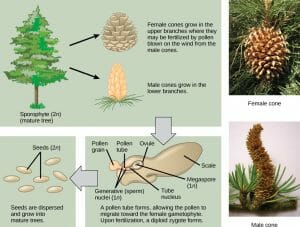The word gymnosperm comes from the Greek words gymnos meaning “naked” and sperm which means “seed.” So, plants that are gymnosperms have naked seeds which distinguishes them from angiosperms whose seeds are enclosed in a fruit or ovary. Gymnosperm plants first evolved in the Carboniferous period around 359-299 million years ago. Today, there are about 1,000 species categorized into 4 divisions: Cycadophyta, Coniferophyta, Gnetophyta, and Ginkgophyta.
Gymnosperms have needle-like or scale-like leaves and no flowers. The leaves have a waxy cuticle that reduces water loss and helps snow to slide off easily, reducing the weight load on the branches. Their wood is softer than that of angiosperms and is used to make paper and lumber. Most gymnosperms are evergreens meaning they don’t lose their leaves seasonally but there are a few species like the larch and tamarack that are deciduous. Gymnosperms are also perennials, growing back every year with no need for replanting.
The reproductive system of gymnosperm plants is located in the cones. For example, in conifers, the dominant phylum of gymnosperms, there are female cones that grow in the upper branches of the tree and male cones grown on the lower branches. Pollination is done mostly by the wind, carrying the male pollen grains to fertilize the megaspores on the female cones.

The image above shows the male and female cones of a coniferous gymnosperm and how the male pollen fertilizes the female megaspore.
References
- OpenStax College. (2017). Concepts of Biology. Houston, TX. Open Stax CNX. Retrieved from http://cnx.org/contents/b3c1e1d2-839c-42b0-a314-e119a8aafbdd@9.39
Characteristics of Gymnosperms
No comments:
Post a Comment